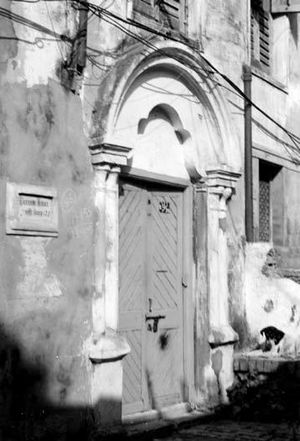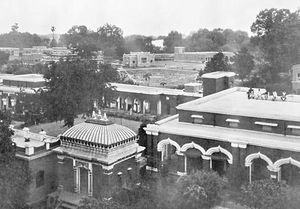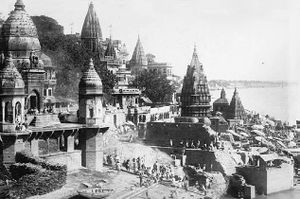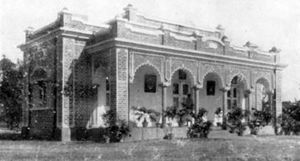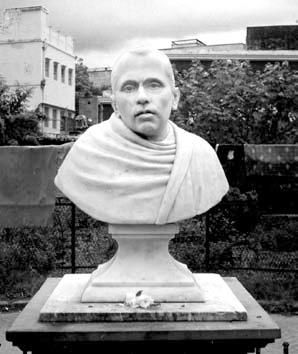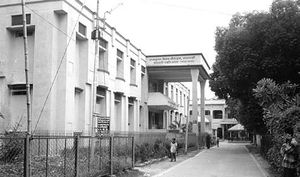Ramakrishna Mission in Varanasi
Varanasi: The Home of Ramakrishna Mission Home of Service[edit]
Varanasi holds a unique place in the Indian religious consciousness. In the Sanatana Dharma, all principles and practices which lead the human soul from its predominantly animal consciousness through human consciousness to divine consciousness have been accepted as valid and true. However, from time to time great saints, sages, and savants have come to propagate yuga dharma—that particular part of philosophy and practice especially conducive to spiritual growth in a particular time. Varanasi is the crucible in which such teachings must be tried and tested before they can be accepted by the world at large. This is an age-old tradition, known since the days of Maharshi Veda Vyasa and Bhagavan Buddha, who promulgated Vedanta and Buddhism from here, and continued in medieval times by Shankaracharya, Ramanujacharya, and Vallabhacharya, who carried out philosophical disputations in Varanasi, establishing as valid their points of view, and writing their treatises. In modern times too, Swami Dayananda Saraswati and others did the same in this city of Varanasi. The Ramakrishna movement is no exception, and that the Ramakrishna Mission Home of Service—which has played a pioneering role in working out the spirit of this movement—has its home in Varanasi is no accident.
Origin of the Philosophy of Service[edit]
But to begin from the beginning, let us narrate a very pertinent incident from the life of Sri Ramakrishna. At the time of his pilgrimage to Kashi with Mathur Babu, when passing through a village near Vaidyanath, Sri Ramakrishna was struck by the poverty and misery of the villagers. He told Mathur, ‘You are but a manager of the Mother’s estate. Give these people sufficient oil to cool their heads and each a piece of cloth to wear and feed them to their fill once.’ At first Mathur was a little hesitant and said, ‘Father, the pilgrimage will require much money, and the poor are too many. I may later be in want of money if I begin to do all that. What do you advise under these circumstances?’ To this the all-knowing and all-loving Master replied, ‘You rascal, I will not go to your Kashi. I will remain here with them; they have none to call their own; I will not leave them behind and go.’ True to his words, he went and sat in their midst. Mathur relented; he ordered cloth from Calcutta and did as the Master bade him. Beside himself with joy to see the villagers happy, the Master bade goodbye to them and gladly resumed his journey to Kashi with Mathur. In this way Sri Ramakrishna corroborated and reiterated the teachings of the Bhagavata:
यो मां सर्वेषु भूतेषु संतमत्मनमिश्वरं ।
हित्वार्चं भजते मौदयान्द्रस्मन्येव जुहोति स: ॥
If one disregards Me present in all as their soul and Lord but ignorantly offers worship only to images, such worship is as ineffective as sacrificial offerings made in ashes.
अथ मां सर्वभूतेषु भूतात्मानं कृतालयं ।
अर्हयेद्यानमानाभ्यं मैत्रयाभिन्नेन चक्षुषा ॥
Therefore, (overcoming the separativeness of a self-centred life) one should worship all beings with gifts, honour, and love, recognizing that such service is really being rendered to Me who resides in all beings as their innermost soul.
True to this spirit of worship of God in human beings, Sri Ramakrishna, like a kalpataru or wish-fulfilling tree, got Mathur to fulfil the needs of those who came to him!
On his visit to Varanasi, Sri Ramakrishna discovered the ‘how’ of the age-old Hindu belief that death in Varanasi gives liberation. The pilgrims took a boat ride on the Ganga. As the boat neared the Manikarnika Ghat, Sri Ramakrishna went into samadhi and saw Lord Vishwanatha himself whispering the supreme taraka mantra in the ear of the jivas from one side of the funeral pyre, and the Mother of the Universe removing the bondages of the soul and freeing it from the cycle of transmigratory existence from the other side. In modern times, the discovery of the ‘how’ of things has been the pursuit of science—and Sri Ramakrishna was a spiritual scientist without parallel.
Though not much is known of Sri Ramakrishna’s first visit to Varanasi, the year of his visit is very significant: it was in 1863, the year in which Biley—Vireshwara, Narendra—the Shiva-avatara Swami Vivekananda was born! Sri Ramakrishna himself narrated that he had brought Naren from the realm beyond the junction of the divisible and indivisible. Both he and Swami Vivekananda were born from that Indivisible Spirit for the good of the world in this age—one a form without a voice, the other a voice without a form! Again, Swami Vivekananda’s mother Bhuvaneshwari Devi propitiated Vireshwara Shiva in Varanasi for a son, through an aunt. Many were her prayers and fasts … and then she was blessed with the vision of Lord Shiva, rousing himself from meditation and taking the form of a male child who was to be born to her.
Swami Vivekananda and Varanasi[edit]
Swami Vivekananda had a deep and ardent devotion to Vishwanatha and to Varanasi, which is revealed in his numerous utterances and writings on as well as his few visits to Varanasi. Swamiji’s visits to Varanasi are particularly memorable. Here occurred that famous incident, between Sankata Mochana and Durga Kunda: Swamiji was being chased by a group of monkeys, but was unable to escape from them, when an old monk called out to him, ‘Face the brutes!’ Swamiji did just that, and the monkeys beat a hasty retreat, revealing to him the life-long lesson of boldly facing the brute. It was to Sri Pramadadas Mitra, the reputed scholar of Kashi, that Swamiji looked for answers to various scriptural questions during his Baranagar monastery days in the 1880s. He also shared with him his Master’s teachings and hoped that Pramadadas Babu would help him acquire funds for his Master’s memorial in Bengal. Unfortunately, Pramadadas Babu did not approve of Swamiji’s efforts. Subsequently, on his penultimate visit to Varanasi in 1890, Swamiji famously declared, ‘I am now leaving Kashi, and shall not return until I have burst on society like a bomb-shell; and it will follow me like a dog.’
Swamiji last visited Varanasi in 1902, after his second visit to the West. In that second visit to the West, Swamiji—the voice without a form—gave his message with no holds barred: a message of the glory of the Spirit! Human glory! ‘Tomorrow night I shall lecture on “The Mind: Its Powers and Possibilities”,’ he would announce, ‘Come to hear me. I have something to say to you, I shall do a little bomb-throwing. … Come on! It will do you good.’ And what bombshells: ‘You are the Personal God. Just now I am worshipping you. This is the greatest prayer. Worship the whole world in that sense—by serving it.’ While Swamiji was delivering his uncompromising message in the West, a group of youngsters inspired by his poem ‘To a Friend’ started the Poor Men’s Relief Association—a medical institution to serve the sick and the afflicted, especially the socio-economically disadvantaged—in Varanasi.
When Swamiji visited Varanasi in 1902, he was very pleased to see that these youngsters, inspired by his life and message, had started serving the sick in the true spirit, in right earnest. However, when he heard the name they had given their association—Poor Men’s Relief Association—he told them, ‘Let service and not compassion be your guiding principle. Transform your work into worship by looking upon all beings as manifestations of the Divine. No one but God can relieve the miseries of jivas. Who are you to conduct poor men’s relief ? … Name your organization The Home of Service—Sevashrama.’ In doing so, Swamiji was reiterating his Master’s words: ‘Who are you to show compassion? No, it cannot be. Not compassion for others, but rather the service of man, recognizing him to be a veritable manifestation of God.’ Later, when the institution became affiliated with the Ramakrishna Mission it came to be called the Ramakrishna Mission Home of Service. In renaming this institution—which enshrined his message—
Swamiji clearly enunciated his philosophy and ethos.
Sri Sarada Devi[edit]
The final stamp of approval on this legacy of Ramakrishna-Vivekananda, on this yuga dharma, came as usual from Holy Mother Sri Sarada Devi. Holy Mother visited Varanasi thrice. She visited first in September 1886, on her way to Vrindavan, like any other Hindu widow of her time, to assuage her grief at her separation from Sri Ramakrishna. One day, during the evening services of Vishwanatha, ‘her spiritual fervour was so highly kindled that unconscious what she was doing she walked to her dwelling place with unusually heavy steps. Questioned about it she exclaimed, “The Master had led me by hand from the temple.”’ Some devotees believe that during her second visit in 1895, she experienced first-hand that Sri Ramakrishna was none other than Baba Vishwanatha.
Holy Mother last visited Varanasi in November 1912, staying two months. Swami Gambhirananda describes that visit:
The very next day Mother went to visit the deities Vishwanatha and Annapurna in a palanquin. On the day following the worship of Kali (i.e., November 9), she visited the Ramakrishna Mission Home of Service, where Swamis Brahmananda, Shivananda, and Turiyananda, Charu Babu (Swami Shubhananda), Dr Kanjilal, and others were present. Kedar-baba (Swami Achalananda) accompanied her palanquin and showed her round. When she had seen every department, she sat down and in the course of a conversation with Kedar-baba expressed great delight at all the houses, gardens, etc., she had seen, and the good management she had noticed. She further added, ‘The Master himself is present here and Mother Lakshmi is here in all her majesty.’ Then she wanted to know how the institution took shape and with whom the idea first originated. After hearing and seeing all about the institution she remarked, ‘The place is so fine that I feel like staying on in Banaras.’ Soon after she had reached her residence, somebody came with a ten-rupee note and handing it over to the head said, ‘Kindly accept these ten rupees as the Mother’s donation to the Sevashrama.’ That note is still treasured there as an invaluable asset.
That day a devotee asked the Mother at her residence, ‘Mother, how did you find the Sevashrama?’ She said calmly, ‘I saw the Master himself present there, and that is why this work goes on here. These are all his work.’
Armed with this view of the Mother, Swami Brahmananda, when he saw Master Mahashaya (M, the recorder of the Gospel of Sri Ramakrishna) coming that way, sent some devotees and brahmacharins to ask him, ‘Mother has said that the Sevashrama is the Master’s work, and that the Master himself is present there. Now what do you say to that?’ Though Master Mahashaya was known to believe that it was contrary to Sri Ramakrishna’s teachings to engage in social service without first realizing God through spiritual disciplines like japa, meditation, and austerity, he smiled broadly and said, ‘It can no longer be denied.’ The sangha janani—the Mother of the sangha, of the whole Ramakrishna movement— thus put her stamp of authority on this yuga dharma.
Swami Brahmananda[edit]
Swami Brahmananda, who took over the reins of the Ramakrishna Mission from Swamiji, also loved Varanasi and the Home of Service and took personal interest in the construction of permanent buildings at the sevashrama. This work of construction was entrusted by him to another direct disciple of Sri Ramakrishna, Swami Vijnanananda.
An incident revealing his wonderful leadership may be mentioned here. At one time, there was some trouble among the monastic brothers of the two ashramas in Varanasi, especially in the sevashrama. Swami Saradananda, the general secretary of the Order, after personally investigating the matter, wrote to Swami Brahmananda that some of those boys were unfit for monastic life and ought to be expelled. But Swami Brahmananda forbade any action, and himself came to the sevashrama to set things right. How did he do it? Simply by requesting all to meditate in his presence and instructing them without making any distinction between the good and the bad. He resolved the entire issue by raising the consciousness of all concerned to a higher level!
As president of the Ramakrishna Math and Ramakrishna Mission, he too unambiguously declared, like Sri Ramakrishna and Swamiji: ‘Those of you who are working in the hospital will also be able to reach the goal and realize the Reality through the practice of pure, unselfish work.’ Again:
True it is that in all creatures He dwells, but His greater manifestation is in man. That is why Swamiji encouraged us to serve mankind. One must have faith that the one Brahman is in man, woman, and all creatures; and with that faith one must learn to serve Shiva in the form of jiva. As you practise this, suddenly one day the veil will be lifted and you will see that it is He who has become everything—man and universe. … You are that all-pervading Shiva; and thus can serve Shiva in the form of jiva.
It was also at the Varanasi Sevashrama that Swami Brahmananda recognized Sri Mahavira Hanuman attending the Rama-nama sankirtana.
Varanasi: City of Seva[edit]
Varanasi has the unique distinction—Kolkata aside—of having been visited and sanctified by Sri Ramakrishna, Holy Mother, Swamiji, and all other direct disciples of Sri Ramakrishna except Swami Ramakrishnananda. Swami Turiyananda, the great Vedantic monk and brother disciple of Swami Vivekananda, stayed at the sevashrama for the last three and a half years of his life, from February 1919, and guided the monastic brothers in their spiritual path through scriptural classes and satsanga. One day he proclaimed: ‘Remember that in this Sevashrama it is not hospital work, nursing a few patients, that is done; it is worship—worship of the Lord Himself. Have faith in the words of Swamiji who was like Shiva. Let your work in the Sevashrama be worship, and you will attain liberation. … Work done in the spirit of worship is the only suitable spiritual discipline for this age.’ He used to say, ‘If even for three days you serve in the right spirit, that is to say, as worship, you will have the vision of the Lord. Those who work in this manner realize this truth in the depths of their being.’
Every year, on the Sunday following Swami Vivekananda’s birthday celebrations, Narayana puja and seva are conducted. In the morning, even as the worship of Sri Ramakrishna, Sri Sarada Devi, and Swami Vivekananda is performed in the temple, the monks and brahmacharins of the sevashrama go round the hospital and worship each and every patient with offerings of flowers, incense, and fruits and sweets, as also by touching their feet, amidst the chanting of Purusha Sukta, Narayana Sukta, and Vedic shanti mantras, to keep the ideal of service as worship burning bright in their minds.
The Ramakrishna Mission Home of Service, Varanasi, truly embodies the spirit of the present age, the spirit of Ramakrishna-Sarada-Vivekananda and the spirit of this ancient land of Shiva. Vyasadeva has beautifully captured this spirit in his ‘Shiva Manasa Puja’:
आत्मा त्वं गिरिजा मतिहि सहचरा: प्राण: शरीरं गृहं
पूजा ते विषयोपभोगरचन निद्रा समधिस्थिथि: ।
संचार: पदयो: प्रदक्षिनविधि: स्तोत्राणि सर्वा गिरो
यध्यत्कर्म करोमि तन्त्दखिलं शम्भो तवाराधनम् ॥
O Shiva, you are my soul, the Divine Mother my intellect; my pranas are your attendants, my body your temple,
its sense-enjoyments your puja, and my sleep, samadhi.
Wherever I walk, I am circumambulating you; all my words are hymns to your glory,
and whatever work I perform is your worship, O Shambhu!
The Ramakrishna Mission Home of Service, which serves Hindus, Muslims, Christians, Buddhists, agnostics, and atheists alike, is a living embodiment of the following verses of Swamiji’s poem—the poem which inspired the founding of the sevashrama and which vividly captures the spirit of the Ramakrishna movement:
From highest Brahman to the yonder worm, And to the very minutest atom, Everywhere is the same God, the All-Love; Friend, offer mind, soul, body, at their feet. These are His manifold forms before thee, Rejecting them, where seekest thou for God? Who loves all beings without distinction, He indeed is worshipping best his God.
- Originally published as "Varanasi" by Prabhuddha Bharata October 2007
, November 2007
and December 2007
editions. Reprinted with permission.

